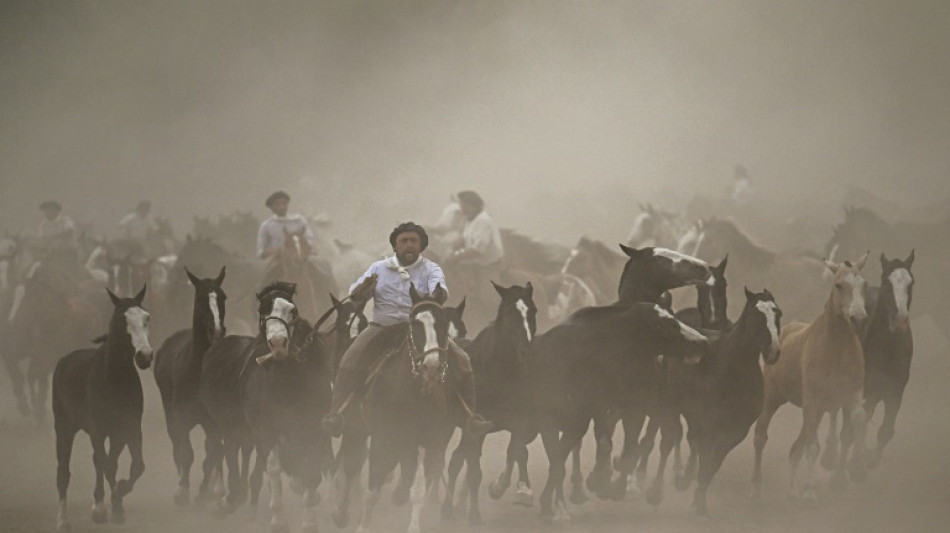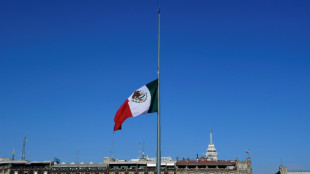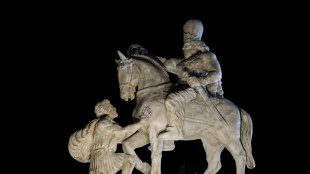
-
 Ireland scramble to scrappy win over Japan
Ireland scramble to scrappy win over Japan
-
De Ligt rescues draw for Man Utd after Tottenham turnaround

-
 Israel identifies latest hostage body, as families await five more
Israel identifies latest hostage body, as families await five more
-
England's Rai takes one-shot lead into Abu Dhabi final round

-
 Tornado kills five, injures more than 400 in Brazil
Tornado kills five, injures more than 400 in Brazil
-
UPS, FedEx ground MD-11 cargo planes after deadly crash

-
 Luis Enrique not rushing to recruit despite key PSG trio's absence
Luis Enrique not rushing to recruit despite key PSG trio's absence
-
Flick demands more Barca 'fight' amid injury crisis

-
 Israel names latest hostage body, as families await five more
Israel names latest hostage body, as families await five more
-
Title-chasing Evans cuts gap on Ogier at Rally Japan

-
 Russian attack hits Ukraine energy infrastructure: Kyiv
Russian attack hits Ukraine energy infrastructure: Kyiv
-
Kagiyama tunes up for Olympics with NHK Trophy win

-
 Indonesia probes student after nearly 100 hurt in school blasts
Indonesia probes student after nearly 100 hurt in school blasts
-
UPS grounds its MD-11 cargo planes after deadly crash

-
 Taliban govt says Pakistan ceasefire to hold, despite talks failing
Taliban govt says Pakistan ceasefire to hold, despite talks failing
-
Trump says no US officials to attend G20 in South Africa

-
 Philippines halts search for typhoon dead as huge new storm nears
Philippines halts search for typhoon dead as huge new storm nears
-
Bucks launch NBA Cup title defense with win over Bulls

-
 Chinese ship scouts deep-ocean floor in South Pacific
Chinese ship scouts deep-ocean floor in South Pacific
-
Taiwan badminton star Tai Tzu-ying announces retirement

-
 New York City beat Charlotte 3-1 to advance in MLS Cup playoffs
New York City beat Charlotte 3-1 to advance in MLS Cup playoffs
-
'Almost every day': Japan battles spike in bear attacks

-
 MLS Revolution name Mitrovic as new head coach
MLS Revolution name Mitrovic as new head coach
-
Trump gives Hungary's Orban one-year Russia oil sanctions reprieve

-
 Owners of collapsed Dominican nightclub formally charged
Owners of collapsed Dominican nightclub formally charged
-
US accuses Iran in plot to kill Israeli ambassador in Mexico

-
 New Zealand 'Once Were Warriors' director Tamahori dies
New Zealand 'Once Were Warriors' director Tamahori dies
-
Hungary's Orban wins Russian oil sanctions exemption from Trump

-
 More than 1,000 flights cut in US shutdown fallout
More than 1,000 flights cut in US shutdown fallout
-
Turkey issues genocide arrest warrant against Netanyahu

-
 Countries agree to end mercury tooth fillings by 2034
Countries agree to end mercury tooth fillings by 2034
-
Hamilton faces stewards after more frustration

-
 World's tallest teen Rioux sets US college basketball mark
World's tallest teen Rioux sets US college basketball mark
-
Trump pardons three-time World Series champ Strawberry

-
 Worries over AI spending, US government shutdown pressure stocks
Worries over AI spending, US government shutdown pressure stocks
-
Verstappen suffers setback in push for fifth title

-
 Earth cannot 'sustain' intensive fossil fuel use, Lula tells COP30
Earth cannot 'sustain' intensive fossil fuel use, Lula tells COP30
-
Wales boss Tandy expects Rees-Zammit to make bench impact against the Pumas

-
 James Watson, Nobel prize-winning DNA pioneer, dead at 97
James Watson, Nobel prize-winning DNA pioneer, dead at 97
-
Medical all-clear after anti-Trump package opened at US base

-
 Sabalenka beats Anisimova in pulsating WTA Finals semi
Sabalenka beats Anisimova in pulsating WTA Finals semi
-
Iran unveils monument to ancient victory in show of post-war defiance

-
 MLS Revolution name Mitrovic as hew head coach
MLS Revolution name Mitrovic as hew head coach
-
Brazil court reaches majority to reject Bolsonaro appeal against jail term

-
 Norris grabs pole for Brazilian Grand Prix sprint race
Norris grabs pole for Brazilian Grand Prix sprint race
-
More than 1,200 flights cut across US in govt paralysis

-
 NFL Cowboys mourn death of defensive end Kneeland at 24
NFL Cowboys mourn death of defensive end Kneeland at 24
-
At COP30, nations target the jet set with luxury flight tax

-
 Trump hosts Hungary's Orban, eyes Russian oil sanctions carve-out
Trump hosts Hungary's Orban, eyes Russian oil sanctions carve-out
-
All Blacks 'on edge' to preserve unbeaten Scotland run, says Savea


Horseman and hero: Who is Argentina's 21st century gaucho?
Riders in berets, espadrilles and traditional neck scarves stand out against a dust cloud enveloping a melee of hundreds of horses as they expertly herd the animals.
The riders are gauchos, deft horsemen who occupy a special place in the Argentine psyche, somewhere between legend and reality.
Every year, thousands of people from all over the country flock to San Antonio de Areco for the Festival of Tradition on December 6.
The city is just 120 kilometers (75 miles) from the capital Buenos Aires, but a different world altogether -- a world of horses, pampas (grassland plains) and gauchos who wear daggers in their belts and play folk songs on guitars around campfires.
Every December 6, Argentina celebrates its national day of the gaucho.
And 2022 is special, marking 150 years since the publication of the poem "El Gaucho Martin Fierro" by Jose Hernandez -- a 2,314-verse ode to Argentina's version of the cowboy.
Translated into dozens of languages, the poem tells the melancholic story of a 19th century gaucho, including his life of nomadic freedom in the expansive pampas and the discrimination he suffered due to his mixed-race origins.
Rebelling against authority and the advance of the city and fences, the character is a cattle thief and brawler.
He is also courageous, loyal and generous, making the gaucho "a kind of rebel 'avenger' in the minds of the poor classes," historian Ezequiel Adamovsky of Argentina's CONICET research council told AFP.
The poem sparked a romanticized obsession with the Argentine horseman and a literary genre that saw dozens of gaucho-themed books "devoured" by rural and working-class readers in particular, he said.
- Political appropriation -
Years later, under a conservative government, Fierro received an extreme makeover, with the anti-establishment rebel becoming a patriotic figurehead of the military, no longer just a popular idol.
In 1913, "El Gaucho Martin Fierro" was declared Argentina's "national poem."
Then, at the start of the 20th century, Fierro became white in the retelling of his tale rather than of mixed race.
It was a time that "the elites of the nation pushed the outlandish but enduring vision of a white, 'European' Argentina," said Adamovsky, an expert on how the image of the gaucho has been massaged through history even as it was elevated to a national symbol.
In Adamovsky's Spanish-language book, "The Indomitable Gaucho," the subtitle calls the gaucho "the Impossible Emblem of a Torn Nation."
Many sectors of Argentine society grasp the gaucho as a symbol. Anarchists rejecting state authority, communists fighting the class struggle, "Peronists" representing the demands of rural workers and nationalists have all since claimed the gaucho for their own.
In San Antonio de Areco, modern-day gauchos herd horses and break them in, showing off their skills to adoring crowds in a world far from folklore and fantasy.
Well-kept horses are mounted with ease by children and octogenarians alike.
"The gaucho, the man of the field, continues and will continue to exist," said Victoria Sforzini, the city's director of heritage.
"It is impossible to replace the work done on horseback," she said, noting that with the territory's diverse topography and vegetation, "there are places where cars cannot go."
So who are the gauchos of 2022?
Are they the riders who perform for tourists on day-long excursions from Buenos Aires? Are they the rural workers who still ply their trade on horseback today?
Or are they like gaucho-descendant Julio Casaretto -- a suburban mason who makes sure to go riding with his little girl on weekends.
"Even if the fields recede, even if everything gets lost a little, it is in our blood," he said.
O.Salim--SF-PST

